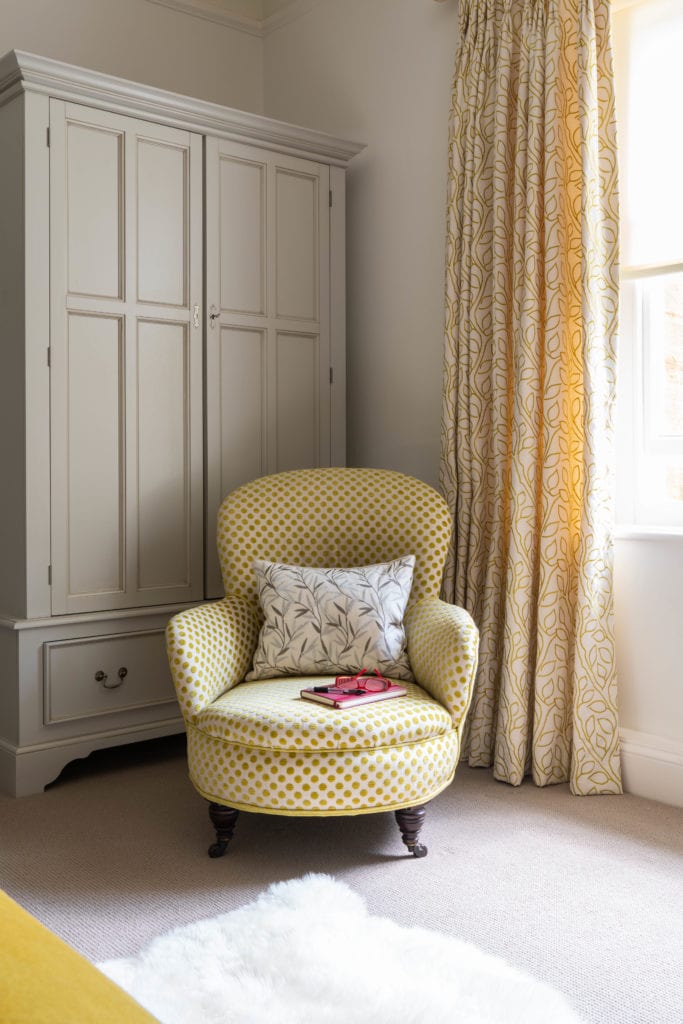Reduce, Reuse, Recycle, we can all do our bit to be more sustainable.
 Fortunately, antique and vintage décor is a wonderful option for interior designers. Furniture and decorative items can be repurposed, refinished or refurbished to give them new life. ‘Up-cycling’ is trendy and many items can be sourced and used to great effect. For the truly environmentally conscious one can always go further – flooring, carpets, fabrics, even sinks and counter tops can be made from recycled materials. See recovered chair and painted wardrobe.
Fortunately, antique and vintage décor is a wonderful option for interior designers. Furniture and decorative items can be repurposed, refinished or refurbished to give them new life. ‘Up-cycling’ is trendy and many items can be sourced and used to great effect. For the truly environmentally conscious one can always go further – flooring, carpets, fabrics, even sinks and counter tops can be made from recycled materials. See recovered chair and painted wardrobe.
Many design houses are moving forward to make an effort to be more environmentally friendly. For example, Ian Mankin www.ianmankin.co.uk is taking positive steps to reduce landfill with their Zero Waste Initiative. This is the start of a series of initiatives to develop creative and environmentally friendly ways for reducing waste, such as yarns and offcuts. This particular exercise takes surplus yarns that are left over from the sampling process or unused in previous collections and turns them into stunning fabrics with sustainability at their heart. Not an easy task when sometimes the quantities are small but the challenge has been accepted and they have succeeded.
Using non-toxic, non-polluting products and materials can help to create a healthier, safer environment for us at home. An increasing variety of safe and chemical-free products are available, from organic, hypoallergenic paint to fibres and woods that haven’t been treated with pesticides. For example; Little Greene Paint and Paper www.littlegreene.com have always been totally committed to the protection of the environment, creating water based paints with the industry’s lowest eco rating and oil based paints that have been reformulated using sustainable vegetable oil. The paper used in their wallpapers comes from certificated sustainable forests; their efforts go on and yet the quality of their products is uncompromised.

We can also of course, look at aspects of lighting. Clever interior design can incorporate windows and skylights to maximise the use of daylight and minimise artificial light. Obviously the most sustainable is natural light but when it is necessary you can carefully consider the type of lighting you use. LEDs and compact fluorescent light bulbs save energy and last longer. Using dimmers and timing switches can all help to make lighting more environmentally friendly – some of these practices are not yet available with all energy efficient bulbs but the way is being paved. The building industry is committed to reducing the environmental impact of lighting; new buildings now include lighting regulation from the outset. While there is still a long way to go before lighting can be said to be strictly sustainable one may say that the future of sustainable lighting looks bright!

Energy-wise materials can be used very successfully in our homes; beautiful flooring can be chosen from materials such as bamboo which is rapidly renewable. Kitchens can be designed with stunning counter tops made from recycled glass, paper composite or recycled aluminium. Or, quite simply, we can use materials from local sources or from companies who promote safe manufacturing processes and are socially responsible.
The World of Interior Design is constantly evolving and improving to reflect demand as we all become more environmentally aware and we love sourcing such products, if you’re interested, come and let’s discuss further, the options are boundless, it certainly doesn’t have to be all or nothing.
